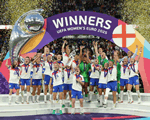Sponsored Links
International Section
- UEFA Euro History
- UEFA Nations League
- FIFA World Cup History
- FIFA Women's World Cup
- 2012 Olympics
- Home Internationals
Cup History Section
UK Season Galleries
-
Premier & Football League
- 2022-2023
- 2021-2022
- 2020-2021
- 2019-2020
- 2018-2019
-
Scottish Professional Football League
- 2022-2023
- 2021-2022
- 2020-2021
- 2019-2020
- 2018-2019
- Previous Seasons>>>
- NIFL Premiership
- FA Women's Super League
Cymru Premier
Other Leagues
Articles
- The History of Football Kits UPDATED
- Eminent Victorians
- Room 101 - The Worst Kits of All Time
- Influential & Classic Kits
- Strange Hues - Colourful Favourites
- Iconic Away Kits
- Historical Football Kits in Print
External Links
The Definitive English and Scottish Football Kit Archive

The material on this site is copyright © Historical Football Kits, all rights reserved. Club crests and sponsors' logos are the intellectual property of their respective owners. For more details visit Copyright Information.
Please note that due to advancing age (I am approaching 70 but unfortunately from the wrong direction) and health issues I am no longer adding new season's kits to the site. Historical updates will continue from time to time.
Latest News & Updates
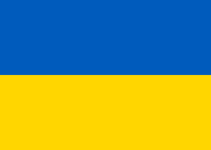
21 November
We have more from the SFA Archive today. Beith (1888-89 corrected), Leith Athletic (1888-89 corrected), Armadale (1888-1891 corrected), Broxburn (1888-89 added), Cambuslang (1888-1893 added), St Johnstone (1888-1890 corrected), Stenhousemuir (1888-1891 corrected), Northern (1890-96 changed to jersey design), Morton (1889-90 added).
Several dates have been adjusted.
19 November
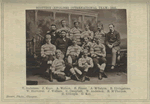 I've been looking at more SFA Annuals today. This photograph is of the Scotland team picked to play England in March 1882. For reasons unknown the team played in blue and white hoops in this match and red and white hoops against Wales, who wore white at the time.
I've been looking at more SFA Annuals today. This photograph is of the Scotland team picked to play England in March 1882. For reasons unknown the team played in blue and white hoops in this match and red and white hoops against Wales, who wore white at the time.
Kilmarnock (1882-84 added, 1887-90 corrected), King's Park (1882-83 jersey altered, 1887-88 corrected), St Mirren (1883-84 hoops on jersey adjusted), Thistle 1886-87 socks corrected), Port Glasgow Athletic (1886-1899 added), Renton (1887-88 removed), Heart of Midlothian (1887-88 added), Leith Athletic (1887-88 corrected), . Several dates have been adjusted.
Photo credit: The Scottish Football Museum
14 November
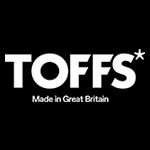 TOFFS are back - it's official!
TOFFS are back - it's official!
Earlier this year The Old Fashioned Football Shirt company (TOFFS) ceased trading. There was no announcement and while their website remained available there were no product links. All my attempts to contact them met with failure while rumours circulated on the internet. I was distressed by this - not only had TOFFS pioneered the market for replica kits, there was a natural synergy between our businesses that led us to build a highly successful affiliate marketing programme that benefited HFK's visitors, enhanced our reputation as the go-to site for replica kit enthusiasts and increased TOFFS sales. In July I reluctantly started to remove TOFFS links from HFK.
In that same month TOFFS was bought by UKSoccershop (UKSS), with whom I also have a long standing and positive partnership. The TOFFS website was relaunched but there was a problem: it turned out that the acquisition of TOFFS did not include its affiliate marketing programme. The issue is in the hands of solicitors and remains unresolved. This meant that while visitors to HFK could once again buy from TOFFS there was no way to monitor traffic and I was not receiving any commission. To make matters worse, last week the affiliate marketing company cancelled all their links on HFK.
After very constructive discussions with UKSS I am pleased to announce that an alternative affiliate arangement is now in place and we are taking the following steps, designed to restore our long-standing connection to TOFFS and rebuild confidence in the brand.
1. Links to TOFFS have been refreshed and now appear as black on a white background to emphasise that we are making a fresh start.
2. Links are once again active for all Premier League, EFL and SPFL teams. Many new links have been added so take a look at your favovourite club pages to see what is avaiable.
3. I will restore links in the international sections next week and will be keep you posted in News & Updates.
4. HFK visitors can now get an exclusive 10% discount on purchases by entering the discount code 10OFFHFK at the TOFFS checkout.
8 November
 We have more from the SFA Annuals today including this captivating advertisement from the 1880-81 edition for Forsyth's Football Costumes.
We have more from the SFA Annuals today including this captivating advertisement from the 1880-81 edition for Forsyth's Football Costumes.
Scotland (1880 kit - pardon me, "costume" - added), Heart of Midlothian (1880-81 added), Stranraer (1877-79, 1879-82 updated), Kilmarnock (1881-82 added),
Photo credit: The Scottish Football Museum
7 November
In the course of our correspondence, Bryan Macpherson kindly gave me access to the Scottish Football Museum's digital archive where a selection of SFA Annuals from the Victorian period are available. These include details of member clubs' colours for each season and I have been sifting through these. In most cases these simply confirm the information we already have but one or two surprises have turned up.
Hibernian (1877-78 cap added), Our Boys (1877-1882 cap & socks corrected), Albion Rovers (1884-85), Cambuslang (1884-85), St Mirren (1884-85 socks), Alloa Athletic (1884-85 cap added),
You can register to view the digital archive for free by visiting The Scottish Football Museum.
3 November
 Last month Bryan Macpherson, Secretary of Clyde FC, got in touch to query my records showing the team wearing red and navy blue tops between 1886 and 1903 whereas entries in the SFA annuals indicate they wore red and black. The Bully Wee are approaching their 150th anniversary and are considering producing replicas of some early jerseys so he was keen to make sure their records were accurate. When I checked with my original sources I discovered that I had made an error when creating the images, which I have now corrected. In the course of checking the records I found this rare action photograph of Clyde playing St Mirren at Barrowfield in 1894 which shows the home team wearing one-inch hooped jerseys. Furthermore in the original email sent to me by Alick Milne in 2007 he quoted a report in the Edinburgh Evening News (24 September 1898) that states that the team's shirts were "quartered in the old university fashion" which I now take to mean they were half and half.
Last month Bryan Macpherson, Secretary of Clyde FC, got in touch to query my records showing the team wearing red and navy blue tops between 1886 and 1903 whereas entries in the SFA annuals indicate they wore red and black. The Bully Wee are approaching their 150th anniversary and are considering producing replicas of some early jerseys so he was keen to make sure their records were accurate. When I checked with my original sources I discovered that I had made an error when creating the images, which I have now corrected. In the course of checking the records I found this rare action photograph of Clyde playing St Mirren at Barrowfield in 1894 which shows the home team wearing one-inch hooped jerseys. Furthermore in the original email sent to me by Alick Milne in 2007 he quoted a report in the Edinburgh Evening News (24 September 1898) that states that the team's shirts were "quartered in the old university fashion" which I now take to mean they were half and half.
The photograph also shows St Mirren wearing black and white vertically striped shirts with white knickers.
Photo credit: Clyde FC.
20 October
 We have more on Maidstone United today. This photograph from 1985-86 reveals various details I was not aware of such as the Rootes' dealership logo moving to the right hand side of the shirt, the reappearance of the traditional crest and the colour of the socks. Although the reserves are pictured, Lee Capeling who submitted the picture assures me the first team wore the same strip.
We have more on Maidstone United today. This photograph from 1985-86 reveals various details I was not aware of such as the Rootes' dealership logo moving to the right hand side of the shirt, the reappearance of the traditional crest and the colour of the socks. Although the reserves are pictured, Lee Capeling who submitted the picture assures me the first team wore the same strip.
Bolton Wanderers (1955-56 added), Queen's Park Rangers (April 1976 kit added), Rochdale (Oct 1976-77 shorts and socks updated).
 Back in the days before the telephone was commonplace, club secretaries would send out notes to those players who had been selected with brief match details and (if the game was to be played away) travel arrangements. This example, submitted by Jon Farrelly, was hand written by Aston Villa Match Secretary, George Copley in 1881 informing a player (addressed only as "Sir",) that he had been selected to play against Walsall Town Swifts the following
Back in the days before the telephone was commonplace, club secretaries would send out notes to those players who had been selected with brief match details and (if the game was to be played away) travel arrangements. This example, submitted by Jon Farrelly, was hand written by Aston Villa Match Secretary, George Copley in 1881 informing a player (addressed only as "Sir",) that he had been selected to play against Walsall Town Swifts the following  Saturday. Both sides wore maroon at the time and the note includes the curt instruction, "white jersey".
Saturday. Both sides wore maroon at the time and the note includes the curt instruction, "white jersey".
Obviously writing these out every week for the first team and reserves was a bit of a chore so a little while later the club introduced pre-printed notes with an impressive letterhead and the Match Secretary just filled in the blanks.
3 October
 In the early 1960s clubs began to transition from the old Continental style to more sleek lightweight shirts with long sleeves and crew necks. A case in point is Brentford seen on the left in their old-style shirts with enormous V necks at the beginning of the 1962-
In the early 1960s clubs began to transition from the old Continental style to more sleek lightweight shirts with long sleeves and crew necks. A case in point is Brentford seen on the left in their old-style shirts with enormous V necks at the beginning of the 1962-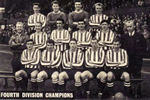 63 season. These were worn up until October after which they were dropped in favour of chic, modern strips seen on the right.
63 season. These were worn up until October after which they were dropped in favour of chic, modern strips seen on the right.
Photocredits: Robin Pearson, eBay.
Maidstone United (1984-85 detailing added and colour corrected), Swansea Town (1956 socks corrected and dates adjusted), Cheltenham Town (1979-80 corrected), Cambridge United (1974-75 authentic crest aded and manufacturer identified).
2 October
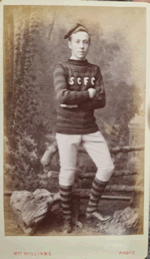 We have a new candidate team for the unknown Victorian footballer featured last month. Tony Smith, who has been studying the image has written to confirm that the studio of Sarah Williams where the photograph was taken was trading in Wolverhampton from around 1876 until 1892. He also suggests that the team our young man played for might be Saltley College FC, who were based at St Peter's College, Saltley, a Christian-faith based teachers' college in
We have a new candidate team for the unknown Victorian footballer featured last month. Tony Smith, who has been studying the image has written to confirm that the studio of Sarah Williams where the photograph was taken was trading in Wolverhampton from around 1876 until 1892. He also suggests that the team our young man played for might be Saltley College FC, who were based at St Peter's College, Saltley, a Christian-faith based teachers' college in 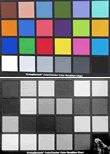 east Birmingham. The club is thought to be the oldest association football team in the Birmingham district, formed in 1870. Their first recorded match took place in February 1873 and they helped form the Birmingham Football Association in 1875. They reached the Birmingham Senior Cup final in 1880 and had two players selected for England.
east Birmingham. The club is thought to be the oldest association football team in the Birmingham district, formed in 1870. Their first recorded match took place in February 1873 and they helped form the Birmingham Football Association in 1875. They reached the Birmingham Senior Cup final in 1880 and had two players selected for England.
Their earliest colours were red and gold hoops and Tony suggests that if the photograph was taken using orthographic film stock the tones would match what we see in the image. If you examine the colour chart you can see that the gold (row 2 column 6) and red (row 3 column 3) tones are a good match for the player's jersey.
Richard Bedwell has found a surprising cutting in the British Newspaper Archive from the Grimsby Daily Telegraph (7 March 1911). This reports that when Lincoln City arrived to play Grimsby Town in the Lincolnshire Cup semi-final they wore black and white striped shirts, identical to those Grimsby had adopted at the start of the season. Quite why Lincoln changed from their usual red and white shirts is a mystery and I have my doubts but, as there is a gap in  my records for this season and its hard to argue with contemporary reports I have added this to the site. If any of HFK's elves feels motivated to look into this further I would be eager to hear from you.
my records for this season and its hard to argue with contemporary reports I have added this to the site. If any of HFK's elves feels motivated to look into this further I would be eager to hear from you.
While trying to corroborate this submission I came across this extraordinary photograph of the 1894-95 Lincoln City team. I've known about the hooped sleeves forever but I had no idea about the hotch-potch of mismatched vertical stripes on the main shirt.
Photo credit: The Stacey West
12 September
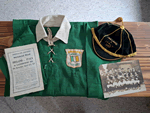 This photograph was sent in by Jonny (jcd from NIFG) and shows various memorabilia from the match between the Irish Free State (Saorstat Eireann) and Italy in April 1927. The picture affords us with the first sight of the crest worn during this period.
This photograph was sent in by Jonny (jcd from NIFG) and shows various memorabilia from the match between the Irish Free State (Saorstat Eireann) and Italy in April 1927. The picture affords us with the first sight of the crest worn during this period.
Photo credit: @SweeperBrady
I've spruced up the Coventry City page with authentic crests for the 1959-61 kits and an alternative strip. Sponsorship on the 1983-84 and 1986-87 kits has been revised.
10 September
 This marvelous photograph was sent to me recently by Caytlann who is trying to find out what team this strapping young chap played for. The headgear, jersey, knickerbockers and hose are all typical of the 1870s and the photograph was taken in the studio of Sarah Williams in Wolverhampton so the team are most likely from the Black Country. I have no record of any team with the initials SCFC in the Midlands from this period (and no it's not Stoke City who were known simply as Stoke FC at the time). If you think you recognise the team please let me know.
This marvelous photograph was sent to me recently by Caytlann who is trying to find out what team this strapping young chap played for. The headgear, jersey, knickerbockers and hose are all typical of the 1870s and the photograph was taken in the studio of Sarah Williams in Wolverhampton so the team are most likely from the Black Country. I have no record of any team with the initials SCFC in the Midlands from this period (and no it's not Stoke City who were known simply as Stoke FC at the time). If you think you recognise the team please let me know.
The saga of Aston Villa's early kits continues to evolve. Lee Gauntlett has found a report in the Bolton Daily Chronicle (31 August 1885) that describes Villa playing in "black and white bars in substitution for the maroon which formerly distinguished them." This implies that the coral and maroon tops were introduced at some point in the prevous season. Both jerseys appeared during the 1885-86 season and the hooped tops were finally ditched in November 1886.
Wimbledon Old Centrals (1892-93 kit added), Chester (1946-47 added), St Johnstone (1885-86 kit corrected, 1922-25 crest confirmed and date of formation revised).
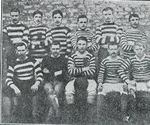 The photograph here is of the original Chester Rovers team from 1884-85 and illustrates how scruffy small provincial teams were in an era when players had to source their own kit. A couple of players have sewn a badge to their jerseys, presumably because they have represented the Cheshire FA while a third has a heart embroidered onto the centre of his top. Bless!
The photograph here is of the original Chester Rovers team from 1884-85 and illustrates how scruffy small provincial teams were in an era when players had to source their own kit. A couple of players have sewn a badge to their jerseys, presumably because they have represented the Cheshire FA while a third has a heart embroidered onto the centre of his top. Bless!
Photo credit: Chester FC
24 July
Here are some more updates from my in-tray, rather more modern than previous entries.
 The sponsored shirts adopted by Raith Rovers at some point in the 1983-84 season added and a previously unrecorded kit worn by Meadowbank Thistle in May 1984 added. Both kits can be seen in the photograph on the left taken on the last day of the 1983-84 season. It's not clear why Meadowbank are in a plain strip but it is possible their shirt sponsorship contract with Sports Conscious (who also provided their kit) had expired. Despite winning 2-1 on the day, Raith were unexpectedly relegated as results elsewhere went against them.
The sponsored shirts adopted by Raith Rovers at some point in the 1983-84 season added and a previously unrecorded kit worn by Meadowbank Thistle in May 1984 added. Both kits can be seen in the photograph on the left taken on the last day of the 1983-84 season. It's not clear why Meadowbank are in a plain strip but it is possible their shirt sponsorship contract with Sports Conscious (who also provided their kit) had expired. Despite winning 2-1 on the day, Raith were unexpectedly relegated as results elsewhere went against them.
(Photo credit: Fife Today)
Cheltenham Town (1978-79 added, 1979-80, 1980-81 collars corrected, one-off 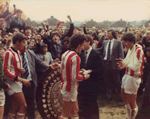 kit worn on 4 May 1985 added.) This last strip featured in the Robins' last home game against Alvechurch when they clinched the Southern League title. Their captain, Paul Collicutt had dislocated his shoulder the previous month against the Worcestershire side and in the return match it went again. Collicutt was rushed to hospital in a taxi while his trainer put his shoulder back in. He returned to Whaddon Road in time to catch the last few minutes and the presentation of the Southerm League shield. With his arm in a sling he needed the help of team mates to lift the enormous trophy.
kit worn on 4 May 1985 added.) This last strip featured in the Robins' last home game against Alvechurch when they clinched the Southern League title. Their captain, Paul Collicutt had dislocated his shoulder the previous month against the Worcestershire side and in the return match it went again. Collicutt was rushed to hospital in a taxi while his trainer put his shoulder back in. He returned to Whaddon Road in time to catch the last few minutes and the presentation of the Southerm League shield. With his arm in a sling he needed the help of team mates to lift the enormous trophy.
(Photo credit: Cheltenham Town FC)
Crest added to Arsenal's white kit worn at Luton Town in 1975.
9 July
Here is a random selection from my in-tray.
The Hallam 1860 graphic now has the correct shade of royal blue jerseys.
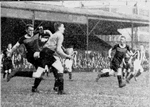 This photograph, submitted by Selwyn Rowley, shows Bradford (Park Avenue) playing at Stoke City at the start of the 1930-31 season. At first glance Bradford appear to be wearing a black strip with a single light band on the upper chest. On closer examination and comparison with better quality reference images, I have come to the conclusion that the Bantams are wearing their regular red, amber and black shirts but the different colours are obscured by the poor quality of the image. Furthermore the hoops are very wide and the lower amber band is tucked away in the players' knickers. If you grew up in the north of England as I did, you will know that your mam wouldn't let you out of the house unless your shirt was neatly tucked in.
This photograph, submitted by Selwyn Rowley, shows Bradford (Park Avenue) playing at Stoke City at the start of the 1930-31 season. At first glance Bradford appear to be wearing a black strip with a single light band on the upper chest. On closer examination and comparison with better quality reference images, I have come to the conclusion that the Bantams are wearing their regular red, amber and black shirts but the different colours are obscured by the poor quality of the image. Furthermore the hoops are very wide and the lower amber band is tucked away in the players' knickers. If you grew up in the north of England as I did, you will know that your mam wouldn't let you out of the house unless your shirt was neatly tucked in.
The socks worn by Arsenal against Barnsley in the FA Cup in February 1936 have been corrected.
My thanks to Mick Comben, chair of the Portsmouth History Society, who has written concerning the link between Field Marshal Montgomery and the adoption of red socks by Portsmouth in December 1947. Read more on the Portsmouth club page.
Photo Credit: The Evening Sentinel September 2 1930.
8 July
Our Grimsby Town Elf, Dave Wherry, has uncovered some fascinating material that sheds light on the club's earliest colours. Firstly it now seems the photograph ascribed to the original Grimsby Pelham is in fact of Grimsby Town and dates from 1882-83. We now have contemporary written evidence from one of the founders of the club that Pelham's original jerseys and socks had broad hoops and were accompanied by a remarkable cap or cowl.
 Dave also found several contemporary head and shoulder images of players wearing striped shirts between 1897 and 1899. We have generally thought that the Mariners wore plain white shirts during this period but further research on the Mariners' Archive website reveals more examples. Football League regulations of the time required teams to have a set of white tops to wear should colours clash so we can assume the stripes were their first choice. The question of colours is more tricky but having pored over as many examples as I could find I have opted for chocolate and light blue. Assuming the portraits were taken using orthographic film, the blue woud be very pale, almost white while the brown would come out dark grey. Of course, given the vagaries of Moor's Law I am almost certainly wrong.
Dave also found several contemporary head and shoulder images of players wearing striped shirts between 1897 and 1899. We have generally thought that the Mariners wore plain white shirts during this period but further research on the Mariners' Archive website reveals more examples. Football League regulations of the time required teams to have a set of white tops to wear should colours clash so we can assume the stripes were their first choice. The question of colours is more tricky but having pored over as many examples as I could find I have opted for chocolate and light blue. Assuming the portraits were taken using orthographic film, the blue woud be very pale, almost white while the brown would come out dark grey. Of course, given the vagaries of Moor's Law I am almost certainly wrong.
Dave also stumbled upon a match report documenting Gainsborough Trinity's stunning 1883-84 strip.
7 July
Our good friend, Tony Sealey, has been busy burrowing into the British Newspaper Archive. Here he found a letter sent to the Tottenham Weekly Herald in 1934 from one HEE Bull whose mother was the proud possessor of the Tottenham Hotspur badge worn in cup games between 1886 and 1888. It turns out that this was a Cambridge blue cockspur embroidered onto a piece of white flannel. Presumably this would be attached to players' shirts with a few stitches so it could be removed for the next (non-cup) match. Tony has also found two variations of the striped shirts worn as a change kit between 1909 and 1912.
20 May
Some time ago I received an email from Martin Nisbet, following up on our previous correspondence about Bolton Wanderers switching to black knickers and red/black socks in January 1950. Having contacted the club's official historian, Simon Marland, Martin uncovered a remarkable back story.
 On 1st March 1939 Nazi troops marched into the remainder of Czechoslovakia in breach of the Munich Agreement. Before Bolton's next home game, the club captain, Henry "Harry" Goslin appealed to the crowd to join the Territorial Army. After the game 32 out of 37 Bolton playing staff joined up, 17 of whom joined their local TA unit, the Bolton Artillery, whose football team, consisting of Wanderers players, is shown here. When war broke out they served in the North Africa and Italian campaigns where Goslin lost his life. The link forged between the football club and TA was a strong one so when it was decided to change the team's traditional colours it seems the new socks were supplied by the 53rd Field Artillery.
On 1st March 1939 Nazi troops marched into the remainder of Czechoslovakia in breach of the Munich Agreement. Before Bolton's next home game, the club captain, Henry "Harry" Goslin appealed to the crowd to join the Territorial Army. After the game 32 out of 37 Bolton playing staff joined up, 17 of whom joined their local TA unit, the Bolton Artillery, whose football team, consisting of Wanderers players, is shown here. When war broke out they served in the North Africa and Italian campaigns where Goslin lost his life. The link forged between the football club and TA was a strong one so when it was decided to change the team's traditional colours it seems the new socks were supplied by the 53rd Field Artillery.
Photo credit & full story: The Observation Post
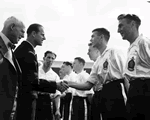 And there's more! If like me you thought that Bolton Wanderers wore their traditional colours in the 1953 FA Cup final you would be WRONG! According to Simon Marland, the team reverted to white and black for the occasion. We know that the management wanted the Bolton team to turn out in kit made from the novel, shiny fabric that was becoming available and I speculate that they could not source navy knickers in this material so opted to revert to black instead.
And there's more! If like me you thought that Bolton Wanderers wore their traditional colours in the 1953 FA Cup final you would be WRONG! According to Simon Marland, the team reverted to white and black for the occasion. We know that the management wanted the Bolton team to turn out in kit made from the novel, shiny fabric that was becoming available and I speculate that they could not source navy knickers in this material so opted to revert to black instead.
 The 1980s were a lean time for Hartlepool United as the club sought to cut costs in the face of mounting financial problems. This might explain why the team shirts did not feature a crest between 1978 and 1985. Nevertheless a new official badge did appear on the cover of their match programmes in 1980-81, as shown on this example found by Mark Alton. Variations of this adorned Pools' programmes until 1985 when a smart new club crest was introduced (and added to their shirts).
The 1980s were a lean time for Hartlepool United as the club sought to cut costs in the face of mounting financial problems. This might explain why the team shirts did not feature a crest between 1978 and 1985. Nevertheless a new official badge did appear on the cover of their match programmes in 1980-81, as shown on this example found by Mark Alton. Variations of this adorned Pools' programmes until 1985 when a smart new club crest was introduced (and added to their shirts).
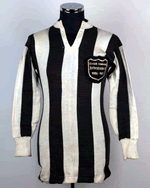 This shirt belonged to Robert Clark, a member of the the Newcastle United team that won the League Championship in 1926-27 and was recently sold at auction for £6000. It is one of several that have survived, some of which are on display in museums. Although there is no doubt that these are authentic, the puzzling thing is that there is no evidence that they were ever worn in a match nor does it appear in any match photographs for the following season, 1927-28. In the opinion of the club's historian, Paul Joannou, the badges were presented to the members of the title winning team, some of whom had them stitched on to their shirts as a souvenir. (Replicas of this historic shirt can be bought from UKSoccershop via HFK's Newcastle United page and will cost you considerably less than six grand).
This shirt belonged to Robert Clark, a member of the the Newcastle United team that won the League Championship in 1926-27 and was recently sold at auction for £6000. It is one of several that have survived, some of which are on display in museums. Although there is no doubt that these are authentic, the puzzling thing is that there is no evidence that they were ever worn in a match nor does it appear in any match photographs for the following season, 1927-28. In the opinion of the club's historian, Paul Joannou, the badges were presented to the members of the title winning team, some of whom had them stitched on to their shirts as a souvenir. (Replicas of this historic shirt can be bought from UKSoccershop via HFK's Newcastle United page and will cost you considerably less than six grand).
Photo credit: Graham Budd Auctions
19 May
Scottish 1997-98 updates contd: Albion Rovers (depth of yoke increased), Motherwell (numbers added to shirt), Aberdeen (collar and trim amended), Dundee United (sleeves & socks adjusted), Rangers (detailing on 2nd & 3rd kits tweaked).
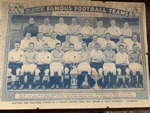 Quite often squad photographs of the bigger Scottish teams had the players decked out in both the first and second kits of the time, a helpful feature for we obsessives. This picture of the Rangers 1936-37 squad is a good example and reveals that the team had reverted to white shirts as their alternative. Notably these had featured the club's monogram crest as far back as 1915, more than 50 years before this appeared on their first choice shirts.
Quite often squad photographs of the bigger Scottish teams had the players decked out in both the first and second kits of the time, a helpful feature for we obsessives. This picture of the Rangers 1936-37 squad is a good example and reveals that the team had reverted to white shirts as their alternative. Notably these had featured the club's monogram crest as far back as 1915, more than 50 years before this appeared on their first choice shirts.
St Mirren (1964-65 stripes on warm weather kit adjusted, hoops on socks of 1964-66 cold weather kit adjusted).
16 May
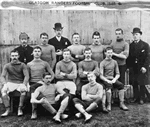 Along with the material uploaded a few days ago, Ian McConnel included this fascinating photograph of Rangers taken in 1885-86. The most striking feature is that some players are wearing dark (ie navy) knickers while others sport the more familiar white. Such variations were not unusual at the time when players provided their own kit but this is the first photographic evidence we have that the 'Gers team were no exception.
Along with the material uploaded a few days ago, Ian McConnel included this fascinating photograph of Rangers taken in 1885-86. The most striking feature is that some players are wearing dark (ie navy) knickers while others sport the more familiar white. Such variations were not unusual at the time when players provided their own kit but this is the first photographic evidence we have that the 'Gers team were no exception.
 While trying to corroborate the 1885-86 image I stumbled across this cutting which confirms Rangers' change strip from 1909-10.
While trying to corroborate the 1885-86 image I stumbled across this cutting which confirms Rangers' change strip from 1909-10.
Photo Credit: Port Glasgow Rangers Supporters' Club.
Now here are some more Scottish club updates from Ian for the 1997-98 season.
Heart of Midlothian (collar and stockings updated), Berwick Rangers (shorts & sock trim corrected), Rangers (collar & cuffs altered), Livingston (trim revised), Raith Rovers (trim on shirt & shorts revised), Dunfermline Athletic (detailing tweaked), St Johnstone (long and short sleeved versions now displayed), Kilmarnock (detailing improved), Clydebank (shorts trim added). More to follow.
13 May
After a lengthy sabbatical to recharge my batteries we're back and kicking off with some very long overdue Scottsh club updates for 1996-97 from Ian McConnel.
Aberdeen (detailing added), Hibernian (raglan sleeves removed, collar redrawn, crest amended), East Fife (shorts trim corrected), Dundee United (sleeves & socks adjusted), Dunfermline Athletic (thigh trim made more prominent), Rangers (detailing added to 1st & 2nd kits), Raith Rovers (cuffs corrected), Kilmarnock (collar detail added, trim on shorts adjusted), Cowdenbeath (shorts altered), Forfar Athletic (graphic added), Ayr United (detailing added).
19 February
I've unexpectedly received some 2023-24 graphics and added these to the site: Brighton & Hove Albion, Burnley, Chelsea, Crystal Palace, Everton, Luton Town, Manchester City, Manchester United, Sheffield United, West Ham United, Chesterfield.
17 February
 With the assistance of Paul Joannou I have begun the further update of the Newcastle United section. So far this has involved some alterations to the text and an overhaul of the West End colours 1882-1892.
With the assistance of Paul Joannou I have begun the further update of the Newcastle United section. So far this has involved some alterations to the text and an overhaul of the West End colours 1882-1892.
The photograph shows the West End team from 1887-88 with the Northumberland Senor Cup.
Photo credit: Newcastle United FC
14 January
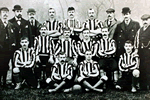 Using Newcastle United: The Ultimate Record 1881-2011 (Joannou, Candlish & Swann 2011) as my point of reference, I have completed a review of Newcastle United's kits from 1881 to 1973. This includes several new graphics for the club's early years as East End but for the most part, the review has captured a lot missing fine details, such as collar trim, variations in the width of stripes and adjustments to dates. We have not been able to confirm that the team photograph published on 2 January is of East End but I have included a graphic in the Change Kit section on a provisional basis because there is some indirect evidence that suggests it might be East End.
Using Newcastle United: The Ultimate Record 1881-2011 (Joannou, Candlish & Swann 2011) as my point of reference, I have completed a review of Newcastle United's kits from 1881 to 1973. This includes several new graphics for the club's early years as East End but for the most part, the review has captured a lot missing fine details, such as collar trim, variations in the width of stripes and adjustments to dates. We have not been able to confirm that the team photograph published on 2 January is of East End but I have included a graphic in the Change Kit section on a provisional basis because there is some indirect evidence that suggests it might be East End.
The club historian, Paul Joannou has assisted me with the review and has offered to look over the results and I anticipate that some further changes will be made as a result.
The photograph shows the team from 1894-95 when the iconic black and white striped shirts were worn for the first time.
Photo credit: Chronicle Live
6 January
While I was sorting out the Northern Ireland 1947 one-off strip I came across a number of other changes that needed to be made to the Home Nations sections - these are listed below.
England: First choice socks from 1946 to 1957 were black with white turnovers.
Northern Ireland: One-off kit from Novermber 1947 added, socks from 1953-1957 corrected and dates adjusted.
Scotland: 1883-1889 crest now confirmed and corrected.
3 January
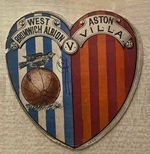 Unravelling the complex and colourful early history of Aston Villa's kits has been one of the more satisfying HFK projects down the years but it seems there are still some twists in the story. Ten years ago I received a press cutting describing Villa's colours in 1885-86 as "coral and maroon." An expert suggested that "coral" was probably a pale shade of blue and so I put together a provisional graphic for the site. A week ago Phil Martin sent me this fascinating item, a "Baines type"colour card issued by Briggs of Leeds to celebrate the midlands derby between West Bromwich Albion and Villa. While it is undated it can only be from 1885-86 as the evidence for the colours of both teams worn in the preceding and following seasons is rock solid. Furthermore, Albion wore their navy and white striped shirts for the first time in 1885-86. While I might be stretching a point I have taken as a clue for the new graphic the fact that the artist has rendered both teams' colours with vertical stripes.
Unravelling the complex and colourful early history of Aston Villa's kits has been one of the more satisfying HFK projects down the years but it seems there are still some twists in the story. Ten years ago I received a press cutting describing Villa's colours in 1885-86 as "coral and maroon." An expert suggested that "coral" was probably a pale shade of blue and so I put together a provisional graphic for the site. A week ago Phil Martin sent me this fascinating item, a "Baines type"colour card issued by Briggs of Leeds to celebrate the midlands derby between West Bromwich Albion and Villa. While it is undated it can only be from 1885-86 as the evidence for the colours of both teams worn in the preceding and following seasons is rock solid. Furthermore, Albion wore their navy and white striped shirts for the first time in 1885-86. While I might be stretching a point I have taken as a clue for the new graphic the fact that the artist has rendered both teams' colours with vertical stripes.
On the subject of unusual colour combinations, Mark Bettany has found new details about Maccesfield Town's 1923-25 kit.
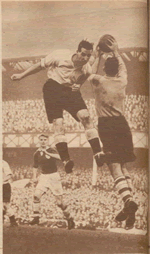 We now turn to this rather puzzling photograph sent to me by Dick Waite last November and published on Facebook. According to the original caption it shows Tommy Lawton in the game against "Ireland" at Goodison Park in 1947. My first response and that of several viewers was that because the Irish team are wearing hooped socks, it must be the Republic of Ireland side, who played at Goodison in 1949. The problem with this interpretation is that Lawton had retired from international football in 1948. Furthermore he is wearing the old FA crest on his shirt which was dropped in 1948.
We now turn to this rather puzzling photograph sent to me by Dick Waite last November and published on Facebook. According to the original caption it shows Tommy Lawton in the game against "Ireland" at Goodison Park in 1947. My first response and that of several viewers was that because the Irish team are wearing hooped socks, it must be the Republic of Ireland side, who played at Goodison in 1949. The problem with this interpretation is that Lawton had retired from international football in 1948. Furthermore he is wearing the old FA crest on his shirt which was dropped in 1948.
I then turned to HFK's Northern Ireland Elf, Jonny from NIFG who was as surprised as I was with the picture but by searching through his photographic archive was able to confirm that this was a one-off. The only explanation I have been able to come up with is that once England had adopted black socks with white tops in 1946 the FA sought to avoid clashes with opponents socks and asked Northern Ireland to play in hoops rather than their usual navy and green set. If you think this attitude is both patronising and arrogant you have some measure of what the FA was like in the post-war period.
2 January
Happy New Year!!
 Today marks a rather important anniversary in the history of association football whch has been commemorated with a blue plaque placed on the site of the old Sheffield Wicker Station by members of the Sheffield Home of Football charity, which is seeking Unesco World Heritage status for the city to mark its importance in the early development of the game. It was from here, exactly 160 years ago, that the Sheffield FC team boarded a Midland Raiway train and travelled to Nottingham to play Nottinghamshire FC (later Notts County) in the first ever inter-city match. The visitors won 1-0 and were presented with the match ball which they then kicked through the streets of Sheffield to their home in Broomhill. The rapid growth of the railway network would play a crucial role in the development of football in the coming decades.
Today marks a rather important anniversary in the history of association football whch has been commemorated with a blue plaque placed on the site of the old Sheffield Wicker Station by members of the Sheffield Home of Football charity, which is seeking Unesco World Heritage status for the city to mark its importance in the early development of the game. It was from here, exactly 160 years ago, that the Sheffield FC team boarded a Midland Raiway train and travelled to Nottingham to play Nottinghamshire FC (later Notts County) in the first ever inter-city match. The visitors won 1-0 and were presented with the match ball which they then kicked through the streets of Sheffield to their home in Broomhill. The rapid growth of the railway network would play a crucial role in the development of football in the coming decades.
Photo credit: BBC
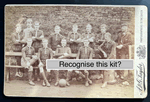 I was recently sent this photograph by a researcher who is working on a website project concerning East End FC, the forerunner of Newcastle United. The reseacher, who wishes to remain anonymous, bought the photograph from a collector in the belief that it showed the East End team from sometime in the late 1880s. He believes he has identified the player perched on what apears to be a chimney pot on the right as Joe McKane who joined East End from Clydebank in 1888 but he has not been able to confirm this. Vertical stripes were still a novelty at this time but the closely fitted shirt with collar and cuffs cut from the same fabric as the main body are remarkably similar to those worn by Aston Villa around this time which seems to support a late 1880s date. The photographer, A&G Taylor (Photographer to the Queen) were based in Carlisle but had four studios in the north-east including one in Newcastle so it's quite possible East End would have patronised the company.
I was recently sent this photograph by a researcher who is working on a website project concerning East End FC, the forerunner of Newcastle United. The reseacher, who wishes to remain anonymous, bought the photograph from a collector in the belief that it showed the East End team from sometime in the late 1880s. He believes he has identified the player perched on what apears to be a chimney pot on the right as Joe McKane who joined East End from Clydebank in 1888 but he has not been able to confirm this. Vertical stripes were still a novelty at this time but the closely fitted shirt with collar and cuffs cut from the same fabric as the main body are remarkably similar to those worn by Aston Villa around this time which seems to support a late 1880s date. The photographer, A&G Taylor (Photographer to the Queen) were based in Carlisle but had four studios in the north-east including one in Newcastle so it's quite possible East End would have patronised the company.
The catch is that I cannot find any source material that confirms East End playing in stripes apart from a fleeting reference in Pioneers of the North (P Joannou & A Candlish 2009) that mentions the team occasionally wore chocolate and blue stripes but provides no dates. If we allow that the players are wearing chocolate, dark and light blue stripes then perhaps this is indeed East End in stripes.
Please get in touch if you can shed any light.






























